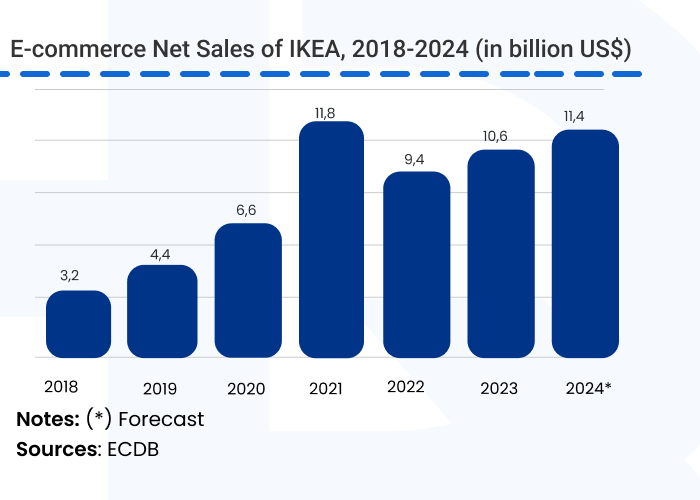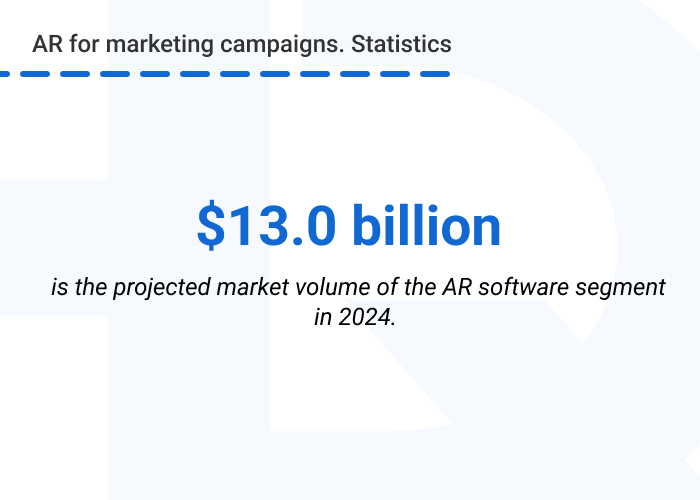What Is Augmented Reality And How Does It Work?
Benefits of Using AR in Marketing Campaigns
HQSoftware’s Expertise: Real-Life Examples
Top 10 AR Marketing Examples for 2025
Limitations of Using Augmented Reality in Marketing
Thanks to the emergence of many new technologies, modern marketing is reaching new frontiers. One such revolutionary technology is Augmented Reality (AR). It allows users to interact with digital content in the real world, creating a unique and immersive experience that traditional advertising cannot match. Today’s consumers are quite choosy and increasingly expect personalized and memorable brand interactions. Therefore, Augmented Reality marketing campaigns have become a powerful tool for companies of all sizes.
This article explores the top 7 examples of impressive AR campaigns, insights into their success stories, and what the future holds for this innovative advertising approach.
What Is Augmented Reality And How Does It Work?
Benefits of Using AR in Marketing Campaigns
HQSoftware’s Expertise: Real-Life Examples
Top 10 AR Marketing Examples for 2025
Limitations of Using Augmented Reality in Marketing
According to ARtillry Intelligence, the mobile AR market is projected to grow from $10.5 billion in 2023 to $21.5 billion in 2028. These figures are truly impressive. They underscore the big potential and increasing significance of AR technology across various industries.
Augmented Reality overlays digital information, such as images, text, or 3D models, onto the real-world environment. Unlike Virtual Reality (VR), which creates a fully immersive digital environment, AR enhances existing reality by adding virtual elements to it. In other words, AR lets you experience the real world with a digital twist.
The key components of an AR experience are:
AR accomplishes this by using computer vision, depth tracking and other advanced algorithms to understand the physical environment and link virtual content to specific places or objects in it. It’s like a digital sixth sense that makes your surroundings come to life in ways you never imagined.

AR marketing offers numerous advantages over traditional advertising methods. Let’s briefly look at some of them!
Improved product visualization: Consumers can visualize the product in the real world before making a purchase, thereby reducing the uncertainty often associated with online shopping.
Interactive branding impressions: Brands can create memorable experiences by embedding AR into their advertising campaigns. For example, a promotional poster can come to life on a user’s smartphone, immersing them in the brand’s story.
Bringing online and offline closer together: Blurring the boundaries between the digital and physical realms can help retailers drive online traffic to physical stores and vice versa. For example, an AR app can direct the user to the nearest store where they can see the product in person after viewing it virtually.
Improving the ease of consumer decision-making: AR allows consumers to instantly access additional information such as reviews, product features or price comparisons. This allows consumers to make more informed decisions right on the spot.
Cost-effectiveness: While initial development costs may be higher, AR campaigns can be highly scalable and cost-effective compared with traditional advertising methods.
Innovation: By using AR technology, brands can position themselves as innovative and forward-thinking, appealing to tech-savvy consumers.
Want to create an AR solution for your marketing campaigns? We’re ready to help!HQSoftware has a team of skilled professionals ready to tackle the project. Ask me!
Anna Halias
Business Development Manager
HQSoftware has extensive experience in creating AR solutions for our customers. Let’s recall some of the projects that demonstrate our expertise and commitment to delivering high-quality AR apps.
Andrey Kazakevich
Head of Production
at HQSoftware“By allowing potential investors to visualize future buildings on undeveloped land, we helped our client secure a significant increase in funding. The five-month development timeframe showcases the efficiency of our team and the power of AR technology in real estate marketing.”
Let’s analyze other cases of Augmented Reality marketing campaigns used by leading brands in 2025.
You’ve probably been in a situation where you wanted to make a home furnishings purchase, but you weren’t sure if it would fit into your home, if it would blend in. IKEA decided to help its customers by taking the guesswork out of furniture shopping and showcase its products in an interactive environment.
In 2017, the Swedish company released the “Place” app for arranging furniture around the house in Augmented Reality. This AR experience allows shoppers to visualize how different pieces of furniture will look and fit together in their home before making a purchase. Want to know if that cozy sofa will match your blue walls? Simply open the app, scan the room and place the digital visualization of the sofa wherever you like. Not happy with the color or size of the sofa? Simply change it to another option with a few taps. Looks simple, doesn’t it?

IKEA Place has made life easier for its customers by providing them with an intuitive, interactive platform to explore numerous design possibilities. And all from the comfort of their own homes! It has turned out to be a winner for the company, too. This Augmented Reality retail campaign has reduced the number of returns and related costs for IKEA.
Want to see a concert by your favorite star, but don’t have the money for a ticket? Don’t get upset. All you have to do is buy a can of Pepsi. And it’s no joke!
In an innovative move, PepsiCo Inc. created an Augmented Reality app that allowed users to experience a fully immersive virtual concert. This groundbreaking AR campaign aims to provide fans with a truly unique and unforgettable experience in the comfort of their own homes.
By simply scanning a Pepsi product with their smartphone camera, users can unlock the “Pepsi Live” AR experience. Their home, backyard, or even car instantly transforms into a virtual concert venue, complete with a life-sized stage, dazzling lights, and high-quality audio system.
In 2021, Pepsi revolutionized the music scene in Malaysia by hosting the country’s first Augmented Reality concert, exclusively for Pepsi fans. The event was headlined by popular artist Siti Nordiana and featured three talented local performers who were winners of the #PepsiBoldTalent audition.
The world of beauty and cosmetics is highly competitive, so brands use different ways to win the hearts of future customers and increase sales. When Sephora released its innovative “Virtual Artist” Augmented Reality app, it strengthened its position as an industry leader. Now people can try on a wide range of makeup products, from lipsticks and eyeliners to foundations and blushes, simply using their smartphone camera.
So how does the app work? Much easier than you might imagine. The program scans the face, determines the location of eyes and lips and analyzes skin tone and complexion, then offers to “try on” various makeup looks. If the user likes a product, he or she can order it immediately.
One of the most impressive features of this Augmented Reality campaign is its ability to simulate different lighting conditions. Users can see how the specific makeup will look in various environments, for example daylight or in a low-light room. This level of detail and accuracy is a game-changer for consumers, who previously had to rely on guesswork or in-store testers when purchasing cosmetics online.
It should be noted that Sephora’s Virtual Artist isn’t just about trying on makeup; it’s also a powerful educational tool. The AR app provides step-by-step tutorials from professional makeup artists. They teach users how to properly apply makeup to their faces. Smoky shadows and blush are applied on a virtual image of the smartphone owner. Sounds cool, doesn’t it? Of course, there are many makeup tutorials on the Internet, but it is much more helpful to apply highlighter on the example of your own face than to watch a blogger demonstrate it on YouTube.
Thanks to digital innovations like this, Sephora has successfully expanded its customer base, enhanced brand loyalty, and boosted its e-commerce net sales from USD 580 million in 2016 to over USD 3 billion in 2022.
Augmented Reality ads can also be a great weapon against competitors, and Burger King proved it. The fast-food restaurant chain launched an AR advertising campaign in Brazil that encouraged users to “burn” competitor advertisements for free burgers. This provocative AR ad, aptly named “Burn That Ad,” was a direct challenge to McDonald’s and other fast-food rivals.
The idea was simple yet daring: users would open the Burger King app and point their camera at any McDonald’s advertisement, be it a billboard, flier or banner on the Internet with a competitor’s logo. Through the power of AR technology, the McDonald’s ad would then appear to catch fire within the app’s interface, revealing a Burger King ad that would take its place. For each “burned” advertisement, Burger King customers received a free coupon for a Whopper burger in the chain’s restaurants.
This innovative Augmented Reality marketing campaign not only captured the attention of consumers but also resonated online, thanks to its bold and disruptive approach. By directly challenging its competitors, Burger King positioned itself as a fearless brand that wasn’t afraid to take risks and push boundaries.
Luxury fashion house Gucci stays ahead of the curve in both fashion and technology. It has pioneered the use of Augmented Reality by creating an “AR Shoe Try-On” feature.
In 2017, Gucci’s mobile app for iOS received an update — Augmented Reality technology, with the help of which anyone could try on shoes at home. At first, the technology worked for the most recognizable sneakers of the brand — the Ace line, with various design options.
How does it work? Using a smartphone, the AR filter allows people to virtually try on popular Gucci sneakers. The mechanism is simple: the customer chooses any pair of Ace shoes, points the camera of his mobile device at his feet, and almost immediately the sneakers are “put on” the feet. The resulting image can be photographed, saved and, if desired, posted on social networks. The program also provides special stickers and wallpapers so that users can customize the devices to their liking.
This innovative Augmented Reality retail campaign not only enhances the overall shopping experience but also addresses a significant pain point for online shoppers: uncertainty about sizing and fit. By providing an accurate representation of how the shoes will look and feel, Gucci has reduced the risk of returns and exchanges, streamlining the e-commerce process for both the brand and its customers.
Every parent knows that asking kids to brush their teeth every day can be quite difficult. But that’s exactly the opportunity the Pokémon team jumped at. They decided to make life easier for parents by creating an AR app called “Pokémon Smile” to help kids brush their teeth correctly and regularly.
“Pokemon Smile” is an awesome interactive app for kids that will help turn the boring brushing activity into a fun process. The game itself can remind kids when it’s time to brush their teeth and helps turn this activity into a leisure activity. It also helps little gamers learn how to brush their teeth correctly, without forgetting to clean the hard-to-reach areas.
With the ability to track a child’s face, the app shows kids wearing the super cute Pikachu cap while brushing their teeth properly. They also get to save Pokémon from tooth decay–causing bacteria through an engaging AR game experience.
The Nike SNKRS app has a cool Augmented Reality game that allows users to virtually unlock exclusive sneaker models. The game has challenges to complete and virtual items to collect, making it fun to use the app and learn more about Nike products.
One particularly ingenious example involves users physically moving and jumping around their environment to “charge up” a virtual sneaker model, which will then unlock once fully powered.
By gamifying the experience and incorporating elements of physical activity, Nike not only created a highly entertaining AR campaign but also reinforced its brand values of athleticism and movement.
From the examples described above, it’s clear that using AR in marketing strategies has valuable advantages. However, it should also be noted that there are also obstacles. For example:
Before diving into upcoming trends, let’s examine some compelling statistics that hint at the immense potential of the AR and VR market.
Every year, AR and VR technologies are becoming more deeply integrated into marketing and sales strategies, opening up new opportunities for brands to engage with consumers. These innovative tools can create unique and memorable user experiences, significantly increasing customer engagement and loyalty. Here are a few key areas where AR and VR are already demonstrating their potential today:
These Augmented Reality examples only hint at the huge potential of AR and VR in marketing and sales, providing companies with a powerful tool to improve the user experience and increase the effectiveness of their marketing campaigns.

As for future trends, AR and VR have the potential to revolutionize the marketing landscape. Here’s a glimpse into what the future holds for AR and VR in marketing:
The transformative power of Augmented Reality in marketing is evident through various successful AR advertising examples. Brands across industries have used AR advertising to create immersive, interactive experiences that captivate consumers and enhance their engagement. Augmented Reality marketing campaigns, such as those by IKEA, Pepsi, Sephora, and others, demonstrate the great potential of AR technology to revolutionize traditional advertising methods.
If you also need to build an AR solution or have any questions on the topic, don’t hesitate to contact us! HQSoftware has a team of skilled specialists ready to give you professional consultation and take on any project.

HQSoftware Founder
Having founded the company in 2001, uses his broad knowledge to drive the company forward. Ready to share his wisdom on software development and technology insights
We are open to seeing your business needs and determining the best solution. Complete this form, and receive a free personalized proposal from your dedicated manager.

Sergei Vardomatski
Founder